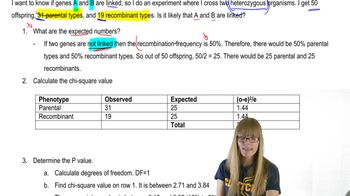The genetic distances between three genes (ab, nm, kf) were determined using a two-point mapping cross. Determine the sequence of the three genes.
Table of contents
- 1. Introduction to Genetics51m
- 2. Mendel's Laws of Inheritance3h 37m
- 3. Extensions to Mendelian Inheritance2h 41m
- 4. Genetic Mapping and Linkage2h 28m
- 5. Genetics of Bacteria and Viruses1h 21m
- 6. Chromosomal Variation1h 48m
- 7. DNA and Chromosome Structure56m
- 8. DNA Replication1h 10m
- 9. Mitosis and Meiosis1h 34m
- 10. Transcription1h 0m
- 11. Translation58m
- 12. Gene Regulation in Prokaryotes1h 19m
- 13. Gene Regulation in Eukaryotes44m
- 14. Genetic Control of Development44m
- 15. Genomes and Genomics1h 50m
- 16. Transposable Elements47m
- 17. Mutation, Repair, and Recombination1h 6m
- 18. Molecular Genetic Tools19m
- 19. Cancer Genetics29m
- 20. Quantitative Genetics1h 26m
- 21. Population Genetics50m
- 22. Evolutionary Genetics29m
4. Genetic Mapping and Linkage
Mapping Genes
Problem 7
Textbook Question
Genes A, B, and C are linked on a chromosome and found in the order A–B–C. Genes A and B recombine with a frequency of 8%, and genes B and C recombine at a frequency of 24%. For the cross a⁺b⁺c/abc⁺ × abc/abc, predict the frequency of progeny genotypes. Assume interference is zero.
 Verified step by step guidance
Verified step by step guidance1
Understand the problem: Genes A, B, and C are linked on the same chromosome, and their recombination frequencies are given. The recombination frequency between A and B is 8% (0.08), and between B and C is 24% (0.24). The goal is to predict the frequency of progeny genotypes for the given cross, assuming no interference (i.e., double crossovers occur at the expected frequency).
Determine the parental and recombinant gametes: The parental gametes are a⁺b⁺c and abc⁺, as these are the original combinations of alleles. Recombinant gametes arise from crossing over between A and B, B and C, or both (double crossover).
Calculate the frequency of single crossovers: The frequency of single crossovers between A and B is 8% (0.08), and between B and C is 24% (0.24). These frequencies represent the proportion of gametes that will result from crossing over in these regions.
Account for double crossovers: Double crossovers involve recombination in both the A–B and B–C regions. Since interference is zero, the frequency of double crossovers is the product of the single crossover frequencies: (0.08) × (0.24). This represents the proportion of gametes that result from double crossovers.
Distribute the frequencies among the progeny genotypes: Use the recombination frequencies to calculate the proportion of each progeny genotype. Parental genotypes will have the highest frequencies, single crossover genotypes will have intermediate frequencies, and double crossover genotypes will have the lowest frequencies. Ensure that the total frequency sums to 1 (100%).
 Verified video answer for a similar problem:
Verified video answer for a similar problem:This video solution was recommended by our tutors as helpful for the problem above
Video duration:
3mPlay a video:
Was this helpful?
Key Concepts
Here are the essential concepts you must grasp in order to answer the question correctly.
Genetic Linkage
Genetic linkage refers to the tendency of genes located close to each other on a chromosome to be inherited together during meiosis. This is due to their physical proximity, which reduces the likelihood of recombination events occurring between them. Understanding linkage is crucial for predicting the inheritance patterns of linked genes, as it affects the ratios of offspring genotypes.
Recommended video:
Guided course

Chi Square and Linkage
Recombination Frequency
Recombination frequency is a measure of the likelihood that two genes will be separated during meiosis due to crossing over. It is expressed as a percentage, indicating the proportion of recombinant offspring produced. In the given question, the recombination frequencies between genes A and B (8%) and between genes B and C (24%) are essential for calculating the expected genotype frequencies in the progeny.
Recommended video:
Guided course

Recombination after Single Strand Breaks
Interference
Interference is a phenomenon in genetics where the occurrence of one crossover event affects the likelihood of another crossover happening nearby. When interference is zero, as stated in the question, it implies that crossovers occur independently, allowing for straightforward calculations of expected genotype frequencies based on the recombination frequencies. This simplifies the analysis of linked genes in genetic crosses.
Recommended video:
Guided course

RNA Interference
Related Videos
Related Practice
Multiple Choice
935
views
4
rank


